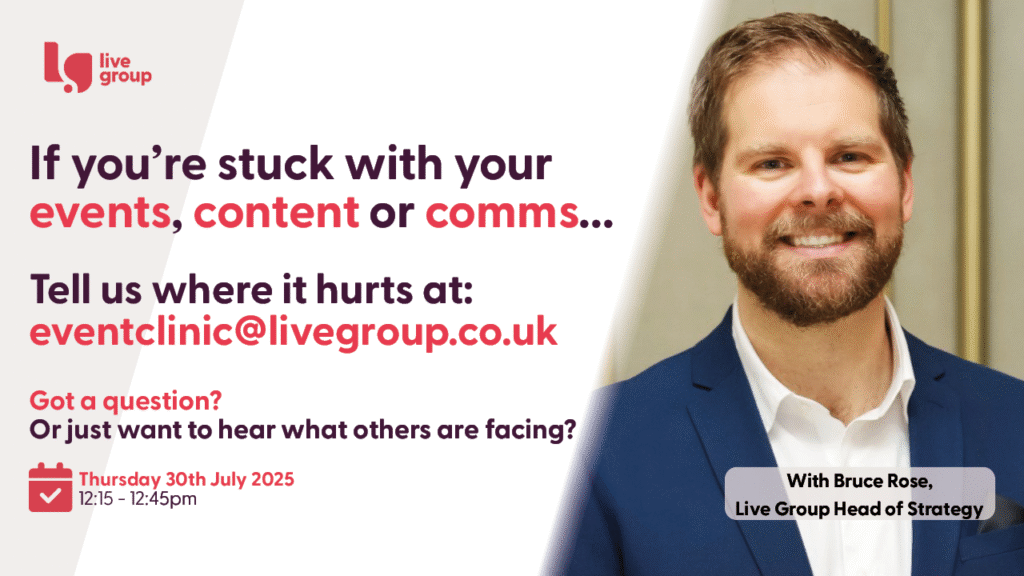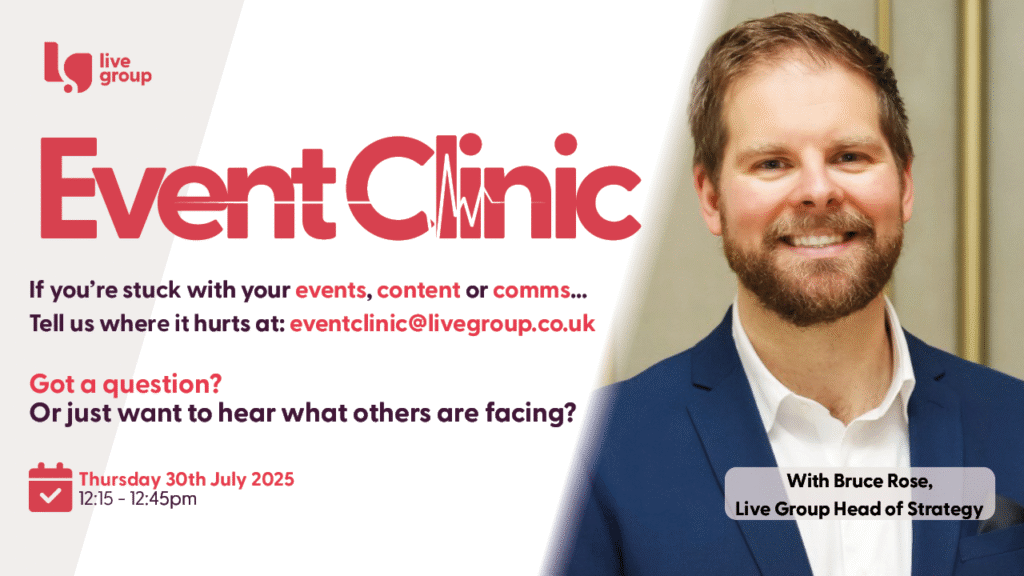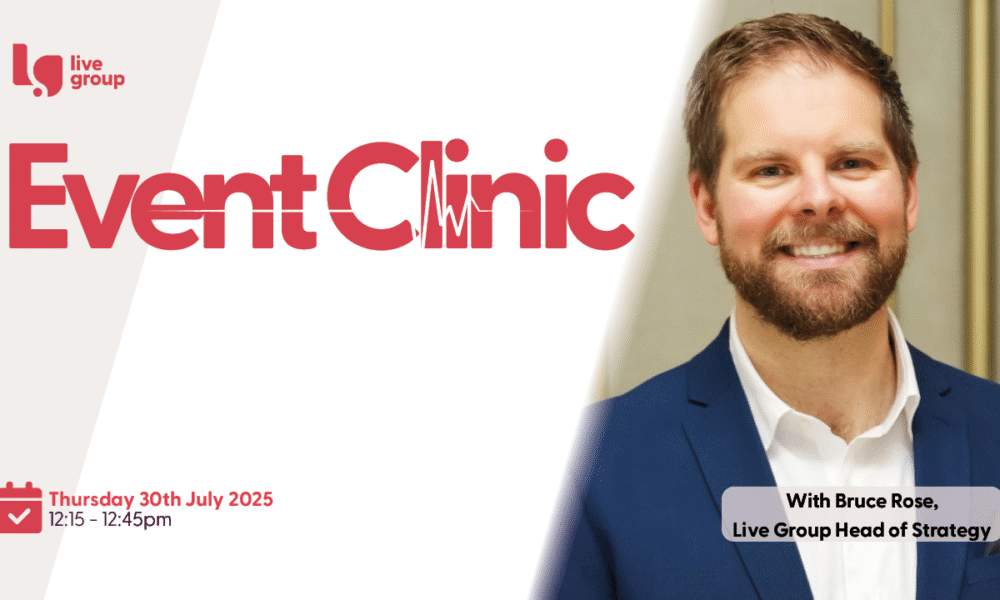Bruce, Head of Strategy at Live Group
Managing event planning in today’s landscape can feel like navigating a minefield of competing demands, technological challenges, and evolving attendee expectations. As someone who’s spent years in the trenches of corporate event planning and strategy, I understand the unique pressures our industry faces.
That’s why I’ve launched the Event Clinic – a monthly series where we tackle real problems submitted by event professionals just like you. In this comprehensive guide, I’ll share the ten most pressing challenges facing our industry today, along with battle-tested event planning solutions that actually work.
Event Planning Challenge 1: The Hybrid Event Divide
The Problem:
“Our hybrid events feel like two separate experiences. How do we create genuine interaction between in-person and virtual attendees without it feeling forced or awkward?”
Virtual attendees often feel like second-class citizens, watching from the sidelines whilst in-person participants enjoy the full experience. This divide damages engagement and defeats the purpose of hybrid events.
The Solutions:
Digital Ambassador Strategy: Designate someone to bridge the physical-digital gap. Your event host should regularly look directly at the camera and acknowledge virtual participants. One client saw 40% increased virtual engagement by having their host check the virtual chat every 15 minutes.
Level Playing Field Approach: Implement hybrid-first interactive elements. Use platforms like Slido where everyone has equal participation opportunities. Golden rule: if virtual attendees can’t do it, nobody can. This means no exclusive microphone privileges for in-room participants during Q&A sessions.
Alternative Option: Create a dedicated virtual studio with a separate digital host. Yes, it’s an additional investment, but it transforms the virtual experience from afterthought to primary channel.
Event Planning Challenge 2: The Expensive No-Show Crisis
The Problem:
“We’re haemorrhaging money on last-minute no-shows despite charging cancellation fees. What strategies actually work to improve attendance rates?”
Events are seeing 20-30% no-show rates even with paid tickets. Traditional reminder emails aren’t cutting it anymore, and cancellation fees aren’t deterring last-minute dropouts.
The Solutions:
Continuous Engagement Strategy: Your event starts when the first invitation goes out, not when doors open. Create a comprehensive communications plan with touchpoints at 30, 14, and 7 days before the event. But don’t just send reminders – build excitement. Share speaker insights, tease exclusive content, promise solutions to pressing problems.
Peer Accountability System: Enable delegate-to-delegate messaging on your registration platform. When someone tells peers they’ll attend, they’re far more likely to show up. Social pressure works where financial penalties fail.
Comms Plan Integration: Your event starts when the first invitation goes out. Build a structured communications plan with touchpoints at 30, 14, and 7 days. Not just reminders – deliver value. Tease speakers, highlight solutions, and keep energy high.
Seamless Transfer Policy: Make ticket transfers frictionless. Remove every barrier – no phone calls, no complex forms, just simple digital transfers. If someone can’t attend, make it easier to transfer than to simply not show up.
Event Planning Challenge 3: The 5% Survey Response Disaster
The Problem:
“Post-event surveys get a 5% response rate at best. How can we gather meaningful feedback without pestering delegates or offering expensive incentives?”
Traditional post-event surveys are failing. By the time you send them, the experience has faded and delegates have moved on. The result? Minimal data to guide future improvements.
The Solutions:
In-the-Moment Feedback: Deploy pulse surveys during the event. Install simple three-button feedback stations (happy/neutral/sad faces) at session exits. One conference achieved 78% feedback participation using this method versus their previous 5% survey completion rate.
Alternative Feedback Channels:
- Set up interview booths for 60-second audio feedback
- Use AI transcription for quick analysis
- Deploy staff for roaming micro-interviews during breaks
- Mine passive data: session attendance, app engagement, networking patterns
Micro-Survey Approach: If you must survey post-event, keep it under five questions, directly tied to your event objectives. Launch during the closing plenary when engagement peaks.
Event Planning Challenge 4: Speaker Management Chaos
The Problem:
“Speakers miss deadlines, ignore tech requirements, and make last-minute demands. How do we keep them on track without damaging relationships?”
Despite being the face of your content, speakers often cause the most operational headaches. Late presentations, ignored technical specifications, and prima donna demands can derail even well-planned events.
The Solutions:
Speaker Portal Implementation: Create a centralised hub where everything lives. Use visual indicators – red lights for missing items create psychological pressure to complete tasks. Make requirements crystal clear and progress trackable.
Dedicated Speaker Success Manager: Assign a named person, not a generic email address. “Sarah from the events team” builds relationships and accountability in ways “[email protected]” never can. This person becomes their advocate and enforcer.
Reset Expectations Framework: Stop being overly grateful. Speakers are your content frontline – they need to be prepared, professional, and punctual. Set clear expectations upfront and hold them accountable. Your attendees deserve nothing less.
Event Planning Challenge 5: Event Agenda Politics
The Problem:
“Building our agenda is a political nightmare. Everyone wants prime slots, sessions overrun, and we end up with death by PowerPoint.”
The CEO wants their pet project featured, every department demands representation, and before you know it, you’ve created an agenda that serves internal politics rather than attendee needs.
The Solutions:
Non-Negotiable Mandates: Create rules in your event plan that remove subjectivity:
- No PowerPoint rule (forces creative session design)
- Format variety mandate (no consecutive sessions of same type)
- Maximum session lengths with automatic cut-offs These become your shield against political pressure.
Data-Driven Decisions: When challenged, point to evidence. Let attendees vote on sessions. Build your agenda around data, not politics – a core principle in modern event planning.
External Facilitator Option: Bring in a neutral third party to design and defend the agenda. It’s easier for an outsider to say no to internal politics.

Event Planning Challenge 6: Networking That Actually Works
The Problem:
“Networking sessions turn into awkward mingles with the same cliques forming. How do we facilitate meaningful connections?”
Traditional networking breaks see 30% of attendees hiding in corners checking emails whilst established groups reform their usual clusters. New attendees feel excluded and valuable connections go unmade.
The Solutions:
Event planning for networking success means going beyond “coffee and mingle.” Design experiences that drive value, from curated topics to structured breakout formats.
Topic Table Structure: Create designated areas for specific discussions – “AI Innovation,” “Sustainability Solutions,” “Digital Transformation.” This provides immediate conversation starters and naturally breaks up cliques.
Tech-Enabled Matching: Use personality profiling or AI-powered matchmaking to suggest connections. When attendees know they’re meeting someone with shared interests or complementary skills, awkwardness diminishes significantly.
Escape Options: Accept that some attendees hate networking. Provide alternatives – quiet spaces, content sessions, or structured activities. Forced networking creates negative experiences.
Event Planning Challenge 7: Proving Real Event ROI
The Problem:
“We’re struggling to demonstrate ROI beyond attendance numbers. What metrics actually matter to leadership?”
Executives want proof that events drive business value, not just headcount. Traditional metrics like attendance and satisfaction scores no longer justify budgets.
The Solutions:
Clear Objective Setting: Before any event, establish measurable objectives. Not “increase brand awareness” but “achieve 30% positive shift in product perception scores” or “generate £500K in qualified pipeline.” Measurable objectives must align with your comms plan.
Behavioural Change Tracking: Implement pre and post-event assessments. For training events, test knowledge retention at one week and one month. Track how attendees apply learning in their roles.
CRM Integration: Connect your registration platform to your CRM. Track how event attendance influences sales pipeline, customer retention, and lifetime value. If these systems don’t talk, you’re missing crucial ROI data.
Event Planning Challenge 8: Authentic Sustainability
The Problem:
“Our sustainability initiatives feel like greenwashing. How can we make genuine improvements with tight budgets?”
Delegates increasingly expect real environmental action, not token gestures. But sustainable options often cost more, and measuring actual impact seems overwhelming.
The Solutions:
Data-First Approach: Start by measuring current impact. Track:
- Travel methods and distances
- Energy usage and waste generation
- Food consumption and disposal Partner with venues that provide sustainability metrics.
Make Green Choices Default: Don’t label options as “vegan” – call them “climate-friendly choices.” Make digital documentation the default, not the alternative. When sustainable options are positioned as premium rather than compromise, adoption soars. Build this language into your event planning comms plan to encourage uptake and shift behaviour.
Local Sourcing Strategy: Use local suppliers to reduce transport emissions. Track improvements across multiple events to show cumulative impact. Hold partners accountable for their sustainability claims with regular audits.
Event Planning Challenge 9: The Sponsor Expectation Gap
The Problem:
“Sponsors want premium placement, data access, and speaking slots for minimal investment. How do we reset these relationships?”
Traditional sponsorship models are broken. Sponsors expect more while paying less, and logo placement no longer justifies investment.
The Solutions:
Value-Based Packaging: Move away from generic offerings. A strong event planning strategy includes sponsor benefits that map to business outcomes – not just logos on screens:
- Guarantee 500 qualified conversations, not “brand visibility”
- Provide detailed engagement metrics, not just footfall
- Offer exclusive content creation opportunities
Extended Engagement Model: Expand sponsor benefits beyond event day:
- Pre-event webinar slots
- Access to year-round communications
- Post-event content opportunities This extended value justifies premium pricing.
Data-Driven Justification: Provide concrete ROI metrics: booth traffic heat maps, session attendance data, lead quality scores. When you prove value with data, price discussions become easier.
Event Planning Challenge 10: The App Investment Dilemma
The Problem:
“Event apps cost thousands but see 30% adoption at best. Are they still worth it?”
Mobile apps promise enhanced engagement but often become expensive digital ghost towns. The cost-benefit calculation increasingly favours abandonment.
The Solutions:
Web App Alternative: Forget forcing downloads. Progressive web apps eliminate barriers and work across all devices. One client’s switch from native to web app saw adoption jump from 35% to 78%.
Ruthless Feature Curation: List every proposed feature. For each, ask: “Will this materially improve the delegate experience?” Cut anything without compelling evidence. Three brilliant features beat twenty mediocre ones.
Every app feature should have purpose. Corporate event planning must balance budget and value – fewer features, stronger engagement.
Clear Success Metrics: Define what success looks like before building:
- Specific adoption targets
- Engagement benchmarks
- ROI calculations If you can’t justify the investment with concrete metrics, redirect funds elsewhere.
Event Planning: Moving Forward with Confidence
These challenges aren’t going away – they’re evolving and multiplying. But armed with these event planning solutions, you’re better equipped to tackle them head-on.
Remember the key principles:
- Your event starts with first contact, not first session – so build a robust comms plan
- Data beats opinion in every decision
- Make the right choice the easy choice
- Measure what matters to your business
Corporate event planning in today’s complex environment is about more than logistics – it’s about strategy, experience design, and measurable outcomes. Whether you’re building your first event or refining a global series, start by asking: What is a comms plan that truly engages? How do I write a comms plan that gets results?
Have your own event challenge? Submit it to [email protected] or connect with me on LinkedIn. The next Event Clinic session might just solve your thorniest problem.
Stay innovative,
Bruce, Live Group






